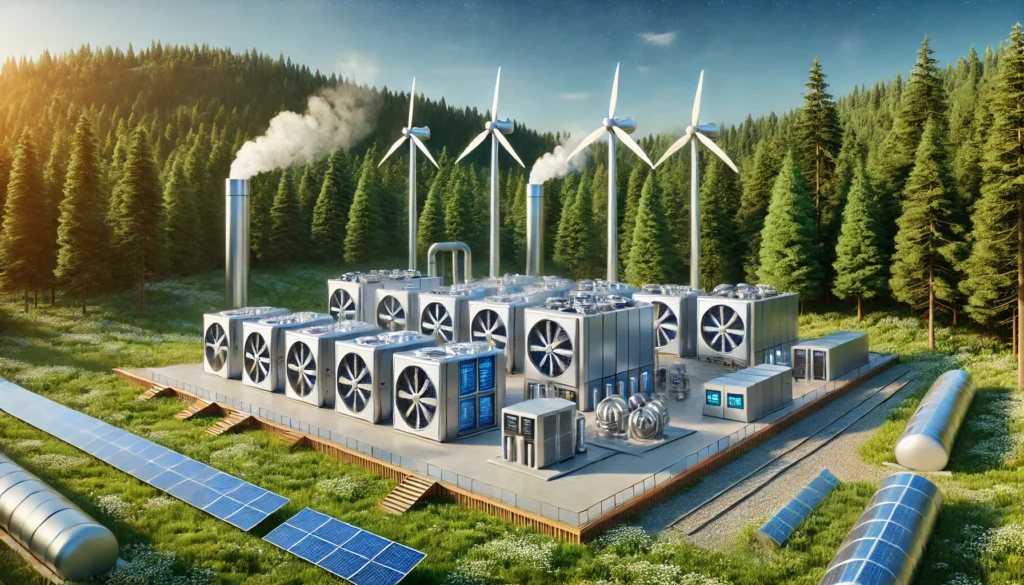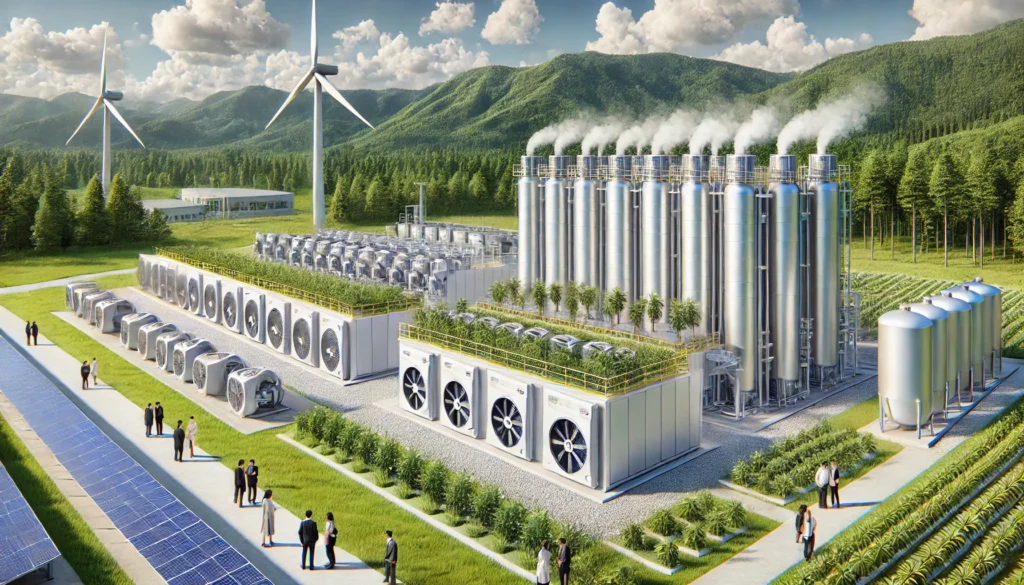Globally, innovation is humanity’s single biggest weapon in the fight against climate change. At the forefront of such efforts is Climeworks – a Swiss-based startup that has emerged as one of the flagbearers for innovation in CDR. Climeworks has pioneered direct air capture of CO2 by Christoph Gebald and Jan Wurzbacher since its establishment in 2009. Now let’s touch upon why Climeworks is a disruptive player in the sustainability industry.
The Vision Behind Climeworks
Climeworks followed a dream of enabling individuals to address climate change problems. The duo, Gebald and Wurzbacher engineering enthusiasts with an overwhelming interest in sustainability, aimed at developing technology that can extract CO2 from the air. Their mission? To make the whole climate positive with permanent CO2 debt elimination from the atmosphere. This ambition has put Climeworks into a position of leading the innovation in direct air capture (DAC).

About the Founders
Christoph Gebald and Jan Wurzbacher have known each other since their student days in Mechanical Engineering at ETH Zürich – the Swiss Federal Institute of Technology in Zürich. They cared greatly for climate change and believed in the engineering world to solve global issues. Post-education, they came up with Climeworks as an endeavor that would seek to capture and remove CO2 from the atmosphere on a commercial basis. They have demonstrated that through their lessons, passion, and knowledge they are leaders in combating climate change.
How Climeworks Technology Was Designed
At the center of Climework’s business model is the direct air capture plants. These amenities employ filters distinct for capturing CO2 from one environment to an additional. The process can be broken down into several key stages:
Air Intake:
Ambient air is drawn into the giant fans and pulled into the building from the environment in which it is located. This air, which contains diverse gases, is guided into the Climeworks system. Depending on the model, the fans are designed to allow free flow of air with little energy consumed in the process to meet the goal of efficiency.
CO2 Capture:
The air then moves through a filter material having amines deposited thereon which is a feature of the patented invention. These amines form a chemical complex with CO2 from the air while passing through other gases in the airstream. This chemical process is highly selective and the system was able to strip off CO2 with a concentration of 0.04% in the environment.
Saturation and Heating:
In due course, the filter is filled with CO2. At this point, the system goes now to the regeneration phase. The filter reaches a temp of nearly 100℃ (212 ℉), causing the CO2 molecules to evaporate from the filter fabric. This heating process is produced from renewable energy sources as may be observed from the use of geothermal or solar energy.
CO2 Collection:
The exhaust CO2 is at a much higher purity than that produced commercially since it is gathered in a concentrated form. This CO2 is then kept in secure tanks at high-purity conditions before it is used for its final use or storage.
Permanent Storage or Utilization:
The idea related to this startup is long-term carbon removal. In most of the cases, the captured CO2 is pumped into basalt formations deep into the ground. In the long run, it complements the rock to form stable carbonate minerals thus sequestering the carbon far from the atmosphere for several millennia. Instead, the CO2 can be utilized in agriculture (for instance for stimulating the growth of greenhouse), to synthesize artificial fuels, or for the production of carbonated products.
Scalability and Modularity:
I didn’t find specific information about the options for the expansion of Climeworks’ DAC plants; nevertheless, Climeworks’ DAC plants are modular. Every plant contains many units, which may be grouped to form the facilities that are capable of capturing thousands of tons of CO2 per annum.
The entire process of constructing this building has also ensured the optimum use of renewable sources of energy and entails lesser waste products. First, Climeworks’ technology has the advantage of scalability, as well as practical design for large-scale carbon capture and utilization.

Applications and Impact
From all these analyses, therefore, it could be concluded that Climeworks’ technology can fit in many industries and thus, it is a useful tool in the coming global fight against climate change. Here are some applications and their potential impact:
Carbon Offsetting: Organisations that wish to establish themselves to be net Zero Emitters, can work in partnership with this startup to mitigate their impact on the environment. This is applicable for firms in technology, financial, and other sectors.
Green Agriculture: The same captured CO2 can help in the growth of the plants in greenhouses and sustainably increase crop yields.
Synthetic Fuels: The pure CO2 collected can be used as feedstock for the synthesis of carbon-neutral synthetic fuels that are important in the transition toward decarbonizing the transportation industry.
Beverage Industry: Captured CO {2} may be applied in the food and beverages industry to carbonate beverages; thus, minimizing dependence on industrial CO {2} sources.
Climate Restoration: It gives back to the environment by permanently sequestering the CO2 beneath the surface and checking the carbon in the atmosphere.
Why Climeworks Matters
These targets are important on a global scale, but they are insufficient to control global warming at 1.5°C. To achieve this, the Intergovernmental Panel on Climate Change (IPCC) proclaims the necessity for massive carbon removal. Climeworks offers an effective, sustainable solution to the problem at hand, while in addition, to emission reduction strategies.
Learn More Facts About Climeworks
World’s Largest DAC Plant: The Orca plant of Climeworks located in Iceland is the largest working direct air capture plant and can remove 4000 metric tons of CO2.
Subscription Model: Of particular interest is Climeworks, a start-up that allows clients to subscribe to carbon removal directly, thus becoming personal and corporate climate actors.
Global First: Climeworks is the pioneer of commercial carbon removal and thus opened the doors of this new sector.
ETH Zurich Roots: The roots of the company can be dated back to ETH Zurich, which is famous for being an innovation and technology developer.
Record-breaking Fundraising: Climeworks secured in excess of $600 million in 2022 to fund the DAC technology and this investment marks the highest level of confidence.
Financial Highlights: Employees’ turnover, Investors and Company’s market status.
Turnover: The real annual revenues of Climeworks have not been disclosed by the company but it is evident that the company has experienced tremendous financial growth because of the growing market for carbon removal technologies. The Orca plant and corporate partnerships as one of the main sources of revenues.
Investors: The Climeworks firm has been able to attract various investors from the venture capital firms as well as various sustainability funds, where companies like Swiss Re have been one of the investors while Climeworks is partnered with Microsoft and Stripe firms. These investments have been useful in widening its operations and the extent of innovation the Company can undertake.
Stock Market Status: Climeworks is still a privately owned firm and cannot be found to be floated in any stock market. Nevertheless, its increasing relevance within the viability realm has attracted attention towards a possible future IPO.
Milestones and Achievements
Climeworks has achieved several notable milestones:
Orca Plant Launch: By the end of 2020 Climeworks unveiled Orca, the largest DAC plant in the world located in Iceland. An Orca vehicle can eliminate about 4000 metric tons of CO2 every year.
Corporate Partnerships: Microsoft, Stripe, and Shopify are among the big brands that have teamed up with Climeworks to help overcome business carbon emissions.
Public Engagement: Climeworks essentially lets people sign up to get their carbon removal services, which means the climate can be saved for everybody.
Global Expansion: The clime-works already envisions its technology greatly and aims at directly removing probably millions of tons of CO2 every year by 2030.
Challenges and Future Outlook

However, there are disadvantages of Climeworks; it is very expensive to run, and expansion, to stimulate the entire globe, will also be costly. Nonetheless, climate change is fast becoming a global priority, and hence a driver for the increased investment in DAC technology. These challenges, however, can be well addressed by Climeworks because its business focuses on innovation and efficiency. Also, the constant improvements in renewable energy and material science are expected to further reduce costs and increase the scalability of DAC-based technologies.
Why Climeworks Started and Why Startups Similar to Climeworks Are So Important
Climeworks can be used to demonstrate that startups are capable of bringing positive change to address global challenges. Through the use of advanced innovation together with a distinct vision, Climeworks brings about optimism and progress amid an overwhelmingly grim climate problem. The success of this gesture brings to light the need to fund and grow innovative solutions that can change our world shortly.
Conclusion
Climeworks is not only one of these startups with a great idea and an ambitious goal; Climeworks is a company that is willing to change the world, and this idea is not innovative at all. Direct air capture is well-positioned to become a critical technology as climate change advances and redesigns the way that societies function. Climeworks has shown what is possible and its experience is more important to other startups trying to create change. If the support for Climeworks continues readers could begin to see a shift in combating climate change and a sustainable future being a possibility.
Climeworks demonstrates that the issues-committing climate change are incredibly sizeable and yet, people can work to build a better world.












